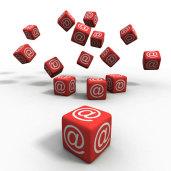
Do you have two hundred emails in the inbox? Do the messages pile up without you being able to reply to each other? Does the sound signal announcing the arrival of a new email annoy you every 15 minutes? Do you receive around twenty newsletters a day that go straight to the bin without you being able to read them? Well ... sometimes we wish email hadn't been invented?
If you answered yes to any of the previous questions, you may be interested in reflecting on some of the dangers of receiving so many emails and how to counter them. Email is a powerful tool, it allows us to communicate and update ourselves but at times it can become an unforgivable distraction at work. I know people who, for no reason (and I say reason to refer to the fact that we have no urgent need), are continually pending from the inbox. A new definition could be coined for these: "employee email". Why does this happen? I believe that there are two essential reasons: the pace at which the society we live is running is so dizzying (thanks to the contribution of the network and the mobile phone) that many people feel the need to be continuously connected and updated. due to poor impulse control and a tendency to rush and be anxious. Unless I'm waiting for a very important email, my mailbox only opens twice a day and stays closed in the meantime. I leave you some tips to make sure that the incoming mail does not become our enemy. 1. Establish a daily routine in reading emails. According to personal needs (real or objective, it is not necessary to deceive ourselves) we can read the emails two, three, four times but make sure you have enough time in these moments to read and respond to the messages that deserve a response. On the contrary, another strategy can be adopted: only open those urgent or very interesting emails that we know we can respond to immediately. Those that would waste us time that we do not have, it is better to leave them closed. 2. Respect the flow of information. Whenever possible, it is best not to leave pending emails that we have not responded to. This creates unnecessary tension. We try to answer emails in the order of arrival. 3. Delete all those messages you have read and replied to. Unless they are important and deserve to be kept, in this case we can move them to a special folder, it is better to delete all messages read. In this way when we open the box of the inbox it will not seem to us to be in full chaos. It would also be better to delete the emails sent. 4. We delete all subscriptions to newsletters that no longer interest us. Normally we delete these messages without even opening them, so ... why not delete them entirely? More than once I have deleted a personal email because it happened in the middle of a large number of unwanted newsletters. 5. Create response units at specific times. This is a strategy that, at least to me, helps me enough. Every day I write direct emails to friends and family, very formal and professional messages that take little time and others that take a lot of time and which generally come from the readers of my blogs (whom I thank for their interest and suggestions). So, I establish three broad categories and dedicate a different time of day to each one. Because? There are two fundamental reasons: 1. The hours of increased productivity cannot be devoted entirely to answering emails; 2. Every person deserves a serious and congruent answer and for this reason, they also deserve a little of our time. I prefer to delay replying rather than replying quickly but giving useless information. Of course, these tips are useless if they are not put into practice. It will probably be difficult at first, but with a little discipline we can finally check our email. What strategy do you use to manage your mailbox?

























